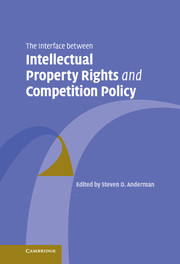Book contents
- Frontmatter
- Contents
- Notes on contributors
- Preface
- 1 The competition law/IP ‘interface’: an introductory note
- PART I Intellectual property rights and competition law in the major trading blocks
- PART II Intellectual property rights and competition law in smaller and medium sized open economies
- PART III Issues related to the interface between intellectual property rights and competition law
- Index
1 - The competition law/IP ‘interface’: an introductory note
Published online by Cambridge University Press: 27 July 2009
- Frontmatter
- Contents
- Notes on contributors
- Preface
- 1 The competition law/IP ‘interface’: an introductory note
- PART I Intellectual property rights and competition law in the major trading blocks
- PART II Intellectual property rights and competition law in smaller and medium sized open economies
- PART III Issues related to the interface between intellectual property rights and competition law
- Index
Summary
Introduction
Competition policy and intellectual property rights (IPRs) have evolved historically as two separate systems of law. Each has its own legislative goals and each its own methods of achieving those goals. There is a considerable overlap in the goals of the two systems of law because both are aimed at promoting innovation and economic growth. Yet there are also potential conflicts owing to the means used by each system to promote those goals. IP laws generally offer a right of exclusive use and exploitation to provide a reward to the innovator, to provide an incentive to other innovators and to bring into the public domain innovative information that might otherwise remain trade secrets. Competition authorities regulate near monopolies, mergers and commercial agreements with the aim of maintaining effective competition in markets. This regulation occasionally results in limits being placed on the free exercise of the exclusive rights granted by IP laws.
In recent decades, competition authorities and courts have prohibited conduct by intellectual property owners which was otherwise lawful under intellectual property rights legislation, because it contravened the rules of competition law. This has occurred in four main spheres of activity of IP owners. First, cases have been brought by the competition authorities in the USA, the EU and Japan to place limits on the anticompetitive commercial conduct of individual owners of IPRs where they protect a market standard or de facto monopoly.
- Type
- Chapter
- Information
- Publisher: Cambridge University PressPrint publication year: 2007
- 2
- Cited by



